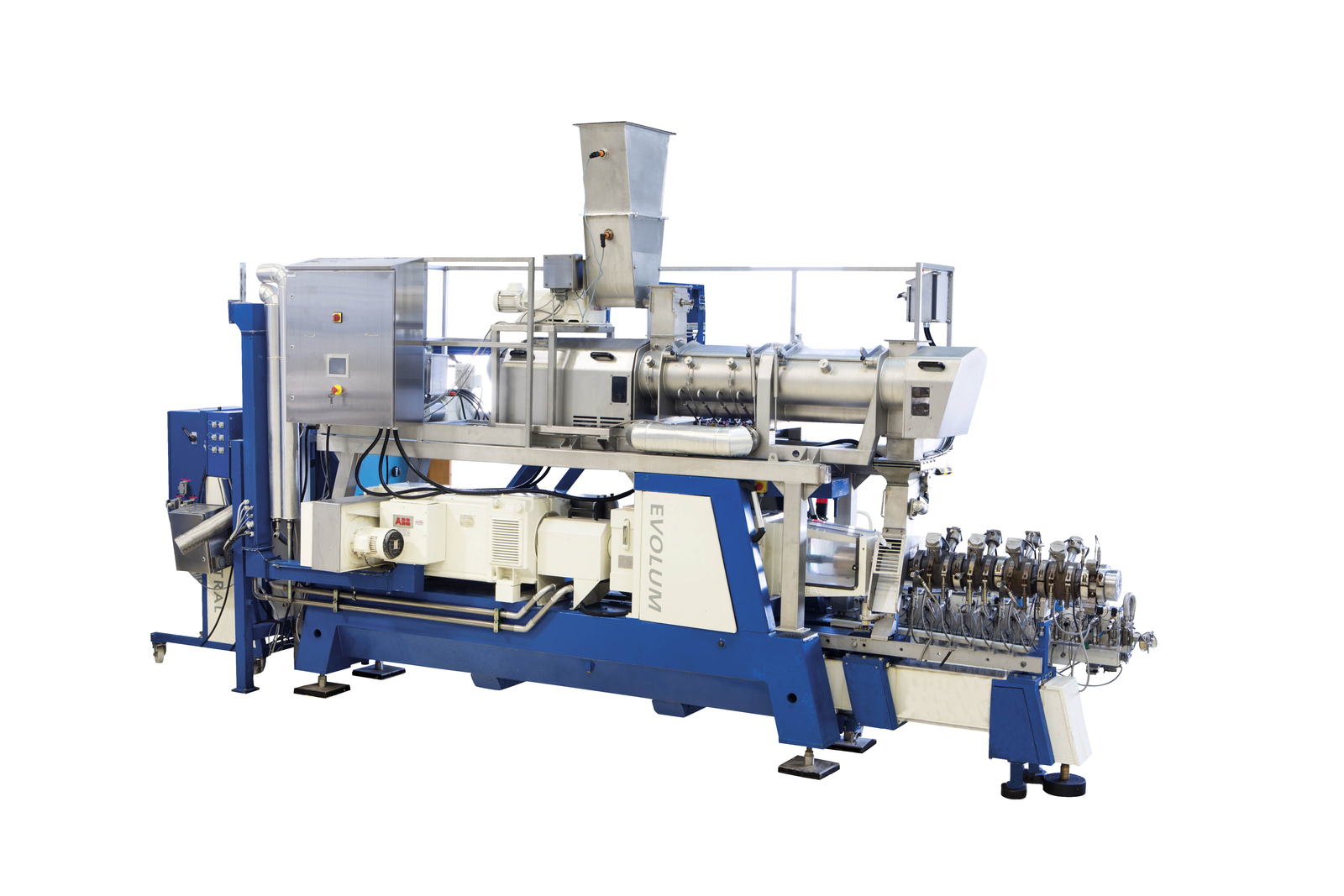Preconditioner for better control of operating parameters

Preconditioners can improve productivity, ?quality and allow greater flexibility in ?controlling process parameters. Trials with a new preconditioner also showed an increased residence time and less energy needed to ?produce the feed.
By Samuel Raymond, R&D engineer, Clextral
Preconditioning systems have generally been used in feed extrusion lines (e.g. dry pet food, fish-feed) to overcome certain limitations that single-screw extruders have in terms of mixing efficiency, cooking and flow capacity. They are currently used in diverse food and feed processing applications in both single-screw and co-rotating twin-screw extruders (TSE). The preconditioner, located directly upstream of the extruder, is an equipment component that makes it possible to hydrate, pre-heat and homogeneously mix powdery raw materials with injected fluids (steam, water and potentially oil or slurries). This operation is carried out on a continuous basis and involves facilitating heat and mass transfer as regularly as possible between the solid, liquid and gaseous phases. The goal is to obtain a homogeneous pre-cooked product that is best adapted to the next stages. The quality of this processing depends in large part on the intensity of the mechanical mixing, but also on the specific thermal and water diffusivity for each product, defined by the exposure time needed for the dry material to be in contact with the steam so that it is properly hydrated and heated. Empirically, a residence time of about two minutes was generally used upstream in the TSE for fish-feed flours. New fish-feed recipes –richer in vegetable proteins and with reduced starch– and new processing throughput and quality requirements for finished products have led to seek preconditioning times around three minutes or more. This increase in preconditioning processing time results in energy and humidity being disseminated to the core of the particles, which is more efficient than simple surface treatment, even when apparently similar temperatures are reached. Eventually, all of the work carried out to prepare cooking and start the starch swelling is as much energy usefully gained by the product for the following stages of the cooking-extrusion processing.
Improved heat and mass transfer
Clextral has developed a new innovative preconditioner (“Preconditioner+”) to respond to process requirements and increase the capacity of existing systems. With the Preconditioner +, the main function – which is to continuously ensure an homogeneous mix of the raw materials – is carried out by two horizontal intermeshing counter-rotating shafts, fitted with adjustable paddles, designed to process the product flow in an optimal way. According to the specific throughput and the physical and chemical properties of each material being processed, it defines a distribution and filling ratio in the mixing unit, directly linked with the residence time required in the end. The key innovation of the Preconditioner +, always aiming to improve heat and mass transfer to the product, is to integrate an Advanced Filling Control device (AFC) which interacts directly on the material inside the mixing chamber and which enables the filling ratio to be adjusted. This AFC system uses a special designed screw inside the tank, and modifies favourably the flow by enabling a partial and controlled recycling of the material being processed, from the outlet to the entry point, thus intensifying the specific preconditioning functions. In addition, the AFC system does not just increase the filling ratio, but also generates better product distribution, in particular in the first third of the mixing chamber which is the preferential zone for steam injection. To achieve this, the different adjustable water and steam injection ports have been optimally positioned –axially and angularly– to enhance absorption and product exposure time during the mixing stage.
Experimental trials
Extensive experimental trials on processing effects have been carried out on the preconditioner+ to assess the improvements generated by its AFC system on the twin-screw extrusion process. In this case, a standard fish-feed recipe (basic salmon feed) was used, without necessarily seeking optimal performance to begin with, but to set an objective benchmark compared to traditional preconditioning systems. The first significant observation was a lowering of the SME (Specific Mechanical Energy) required in the extruder –an average of 3% with equal extrusion parameters– mainly due to the increase of preconditioning time, and largely compensating the additional consumption of the preconditioner. As mentioned previously, this efficient pre-cooking also enables a reduction of the shearing and the torque used in the extruder, which also is beneficial in reducing the wear of the screws and barrels. By focusing exclusively on the preconditioner, the experiment also demonstrated that the new filling ratio (up to 75%) achieved by using the AFC, made it possible to increase residence time by 60% for an equivalent fish-feed flow and therefore to go beyond the average of three minutes sought. At the same time, the combination filling/steam distribution made it possible to increase the product temperature by 3-4°C at the outlet of the preconditioner, using comparable steam injection. It is even possible to achieve product temperature of over 96°C with optimised steam injection, while limiting energy loss thanks to the new design. Following the improvements on the pre-cooking stage, we were able to measure a significant increase of the gelatinisation of starches before their insertion into the extruder. Finally, on the finished product after extrusion, granulation and drying, these upstream modifications resulted in increased hardness of the pellets of at least 10 to 15%, an essential quality criterion required for their use in fish rearing farms.

View of the AFC and agitating paddles inside the chamber of the Preconditioner +.
Increased flexibility
Beyond the process benefits on product quality, it is important to stress that this equipment has also been designed to facilitate industrial applications, in particular due to the increased flexibility provided by the AFC. This variable-speed device makes it possible to adjust the residence time as required and thus adapt the equipment to different types of recipes, thus responding to the need to have multi-product extrusion lines. Moreover, this convenient design allows the system to start up when fully charged, even after prolonged down time with a full tank, thanks to the new kinematic feature. The preconditioner can be easily adapted to single-screw or twin-screw extruders in various food processing applications that require a mix or the pre-cooking of raw materials, such as those used for making pet foods, corn flakes, pre-gelled flours or starches, pellets among others.
[Source: AllAboutFeed magazine Vol 22 nr 4, 2014]











